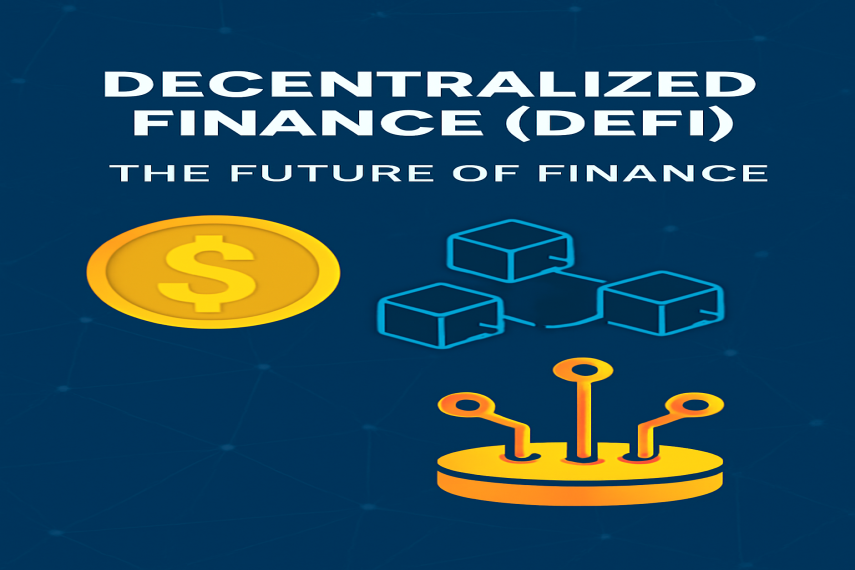
In recent years, Decentralized Finance (DeFi) has emerged as one of the most transformative concepts in the world of cryptocurrency and blockchain technology. By offering an alternative to traditional financial systems, DeFi has the potential to reshape the way we handle everything from loans and savings to investments and insurance.
In this article, we’ll explore what DeFi is, how it works, and why it’s considered the future of finance.
Decentralized Finance (DeFi) refers to a set of financial services and applications built on blockchain networks, primarily Ethereum. Unlike traditional finance, where centralized institutions like banks control transactions and data, DeFi eliminates intermediaries. This decentralized structure allows users to have more control over their financial assets while maintaining transparency and security through smart contracts.
Smart contracts are self-executing contracts with terms directly written into code. These contracts automatically execute actions (like transferring funds) when predefined conditions are met, ensuring trust without the need for third-party intervention.
DeFi operates on blockchain technology, the backbone of cryptocurrencies. It leverages the features of blockchain to create financial applications that are transparent, permissionless, and accessible to anyone with an internet connection. Here’s how it works:
Smart Contracts: The foundation of DeFi is smart contracts. These contracts are written on blockchain platforms like Ethereum, enabling the execution of financial agreements without intermediaries.
Decentralized Platforms: DeFi platforms are decentralized, meaning there’s no central authority or institution controlling them. Popular DeFi platforms include Uniswap, Aave, Compound, and MakerDAO.
Tokenization: DeFi allows assets, like real estate, stocks, or even physical goods, to be tokenized and represented digitally on the blockchain. This enables fractional ownership and broadens access to investment opportunities.
Decentralization: No middlemen or centralized entities are involved in DeFi. This eliminates fees charged by banks and financial institutions, while also reducing the potential for fraud and manipulation.
Transparency: All transactions on the blockchain are visible to everyone, ensuring a high level of transparency. The public ledger allows for greater accountability and trust in financial dealings.
Open Access: DeFi is accessible to anyone with an internet connection, regardless of location or socio-economic status. Traditional financial systems often leave people in developing regions without access to basic financial services, but DeFi enables global inclusion.
Interoperability: DeFi platforms can interact with one another seamlessly. For instance, users can borrow from one platform and lend to another, creating an interconnected ecosystem that is greater than the sum of its parts.
Security: With blockchain’s immutable and transparent nature, DeFi platforms are often more secure than traditional financial systems. However, this security is reliant on the code itself, meaning smart contract vulnerabilities can still be a risk if not properly audited.
DeFi enables a wide range of financial activities, providing an alternative to nearly every financial service available in traditional banking:
Lending and Borrowing: With platforms like Aave and Compound, users can lend their cryptocurrency and earn interest. Alternatively, they can borrow crypto by providing collateral, all without needing a bank as an intermediary.
Decentralized Exchanges (DEXs): Platforms like Uniswap and SushiSwap allow users to trade cryptocurrencies directly with each other, eliminating the need for a central exchange. This provides better privacy and lower fees.
Staking and Yield Farming: In DeFi, you can earn rewards by staking your assets or participating in yield farming. Yield farming allows users to provide liquidity to decentralized exchanges in exchange for interest or tokens.
Stablecoins: Stablecoins, such as Dai or USDC, are a vital component of DeFi. They are digital assets pegged to traditional currencies like the US Dollar, offering a stable value and making them useful for lending, borrowing, or trading.
Insurance: DeFi also allows for decentralized insurance solutions, where smart contracts are used to automate claims and payouts without the need for an intermediary.
Lower Fees: By eliminating intermediaries, DeFi significantly reduces transaction fees, making financial services more affordable.
Accessibility: Anyone can access DeFi services, whether they are in a developed country or an emerging market.
Greater Control: Users retain full control over their funds and assets, unlike in traditional finance where banks and financial institutions hold custody of your money.
Earn Passive Income: By participating in lending, staking, and yield farming, users can earn interest or rewards on their crypto holdings, creating opportunities for passive income.
While DeFi presents numerous benefits, it’s not without its challenges:
Smart Contract Risks: If the code behind a smart contract has vulnerabilities, hackers could exploit them, leading to the loss of funds. Proper auditing of smart contracts is essential.
Regulatory Uncertainty: The decentralized nature of DeFi creates challenges for regulators. Governments are still figuring out how to deal with DeFi platforms in terms of taxes, consumer protection, and legality.
Scalability Issues: Blockchain networks like Ethereum are often congested, leading to high transaction fees and slower transaction times during periods of high activity. However, upgrades like Ethereum 2.0 aim to address scalability issues.
The future of DeFi looks incredibly promising. With the continued growth of blockchain technology and the development of new use cases, DeFi is expected to expand into more financial services, from mortgage lending to insurance. It’s likely that we’ll see more institutional adoption, especially as governments and regulators find ways to integrate DeFi into the broader financial ecosystem.
As the technology matures, we may also see more cross-chain interoperability, where assets and applications can seamlessly interact across different blockchain networks.
Decentralized Finance (DeFi) is undoubtedly a game-changer for the future of finance. By providing greater accessibility, lower fees, and enhanced security, it has the potential to revolutionize traditional financial systems. While there are risks to consider, such as smart contract vulnerabilities and regulatory uncertainty, the benefits of DeFi are clear.
Whether you’re an investor, a developer, or someone looking for alternative financial solutions, DeFi offers vast opportunities. It’s an exciting time to be involved in the world of decentralized finance, and 2025 could be a year where DeFi takes even bigger steps forward.